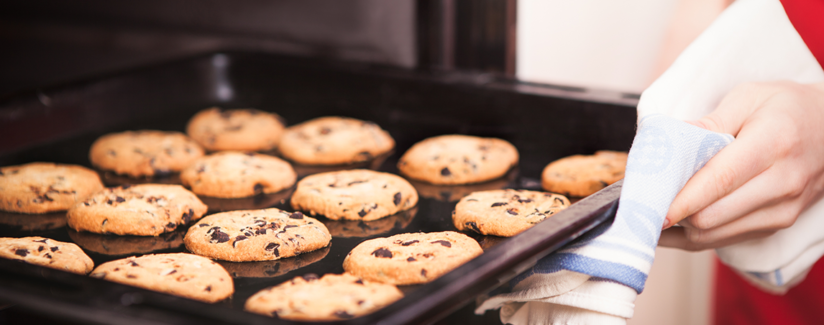
Baking Questions Answered With Science
08/21/2018
While baking your favorite treats have you ever had a cake fall and wondered what happened? Or discovered you’re out of butter and need to know if there’s a substitute? We met up with Dr. Rebecca Miller Regan, assistant professor of bakery science at Kansas State University, to find answers to five of our biggest bakery questions.
What is the difference between baking soda and baking powder?
The Answer: Both baking soda and baking powder release carbon dioxide gas bubbles which helps batter and dough to rise. Recipes that use baking soda require an acidic ingredient such as buttermilk or honey to help extract all of the carbon dioxide gas. Recipes that do not contain acidic ingredients and that need more leavening than the baking soda alone can provide are made with baking powder.
The Science: Chemical leavening occurs when a leavening base and a leavening acid react in the batter to create carbon dioxide gas bubbles which are what makes the batter rise (leaven) during baking. Baking soda (sodium bicarbonate) is a leavening base and the source of the carbon dioxide. Less than half of the total amount of carbon dioxide in the baking soda is released by the heat in the oven and available to leaven the batter during baking. Acids are used to lower the pH of the batter which allows all the carbon dioxide in the baking soda to be released and used for leavening. Some recipes contain acidic ingredients such as buttermilk, sour milk, vinegar, fruit, fruit juice, sour cream, yogurt, honey, cocoa and molasses. In some baked products, this small amount of carbon dioxide gas released by heating in the oven is sufficient, so the recipe only calls for baking soda. Other baked products contain enough acidic ingredients to cause the right amount of carbon dioxide release from the baking soda.
Baking powder is a blend of baking soda, plus one or two chemical leavening acids. There are many different chemical leavening acids available which have different reaction rates and times. Most household baking powders are double acting, meaning they contain a fast-acting and a slow-acting leavening acid. The fast-acting leavening acid reacts during mixing to help make the batter more airy or fluffy. The slow-acting leavening acid reacts during baking, to help make the baked product rise in the oven
Can you substitute margarine for butter in a recipe?
The Answer: Yes, margarine can be substituted for butter in a recipe.
The Science: It is a simple substitution with no adjustments. Be sure to use margarine which comes in sticks and NOT the spreads which come in tubs.
For more information, see What’s the difference between butter and margarine?
What is the difference between using a glass pan or a metal pan? Does it matter which one you use?
The Answer: Yes, it does matter because the two materials transfer heat differently.
The Science: During baking, heat is transferred from the oven through the pan and into the batter or dough. This means the baked product bakes from the sides toward the middle and from the bottom toward the top. Glass and metal transfer heat differently. Glass takes longer to heat up and to cool down than metal. This means that it will take longer for the batter or dough to start baking in the glass pan and it will keep baking for longer after the pan is removed from the oven. It is standard to lower the baking temperature by 25°F and lengthen the baking time by about 10 minutes when baking in a glass pan compared to a metal pan.
Why do cakes fall?
The Answer: When the starch in flour does not gelatinize, like in cakes with more sugar than flour, the structure does not set and the cake will fall. In high-ratio cakes, use cake flour to keep them from falling.
The Science: The structure of a cake is set when the starch in the flour gelatinizes during baking. Most layer cakes eaten in the US are high-ratio cakes which means they have more sugar than flour in the recipe. The high level of sugar increases the gelatinization temperature of the starch in the flour to higher than the boiling point of water. It is not possible to raise the temperature of the cake batter that high during baking, so the starch does not fully gelatinize. This causes the cake to fall during cooling because the structure is not completely set. This problem can be fixed by using cake flour. Flour for high-ratio layer cakes is tumbled with chlorine gas which oxidizes the starch. The oxidized starch absorbs more liquid and swells faster so it does completely gelatinize and the structure of the cake is fully set by the end of baking and does not fall. In low-ratio cake recipes, the amount of sugar is the same or less than the amount of the flour. The sugar level is not high enough to raise the starch gelatinization temperature so the cake does not fall. In these cakes, it is not necessary to use chlorinated cake flour.
Why do cakes crack at the top?
The Answer: A delayed release of carbon dioxide from double-acting baking powder will build up and the pressure from the built-up gas will break the cake crust causing a crack.
The Science: Cakes are usually leavened with double-acting baking powder which contains sodium bicarbonate and two leavening acids. One leavening acid reacts in the batter during mixing and the other reacts during heating in the oven. The heat-activated leavening acid that must react at the correct time during baking. If the leavening acid reacts too late after the top crust of the cake has formed, the cake cannot expand when the carbon dioxide gas is produced in the leavening reaction. This causes a buildup of pressure inside the cake which can cause the top surface to crack to release the pressure.
Learning the science behind baking can help make the process more fun and rewarding. Ready to try out your baking skills? Check out our Pinterest board for more tips and recipes!


























